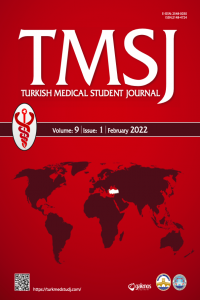CANNABINOID RECEPTORS ARE NOT INVOLVED IN ANTINOCICEPTION INDUCED BY SYSTEMIC DICLOFENAC IN MICE
CANNABINOID RECEPTORS ARE NOT INVOLVED IN ANTINOCICEPTION INDUCED BY SYSTEMIC DICLOFENAC IN MICE
AM-251, AM-630, antinociception, cannabinoid receptors, diclofenac,
___
- 1. Ulugol A. The endocannabinoid system as a potential therapeutic target for pain modulation. Balkan Med J 2014;31:115-20. 2. Schrot RJ, Hubbard JR. Cannabinoids: medical implications. Ann Med 2016;48:128-41. 3. Sastre-Garriga J, Vila C, Clissold S et al. THC and CBD oromucosal spray (Sativex (R)) in the management of spasticity associated with multiple sclerosis. Expert Rev Neurother 2011;11:627-37. 4. Mallet C, Daulhac L, Bonnefont J et al. Endocannabinoid and serotonergic systems are needed for acetaminophen-induced analgesia. Pain 2008;139:190-200. 5. Rogosch T, Sinning C, Podlewski A et al. Novel bioactive metabolites of dipyrone (metamizol). Bioorgan Med Chem 2012;20:101-7. 6. Crunfli F, Vilela FC, Giusti-Paiva A. Cannabinoid CB1 receptors mediate the effects of dipyrone. Clin Exp Pharmacol P 2015;42:246- 55. 7. Hamza M, Dionne RA. Mechanisms of non-opioid analgesics beyond cyclooxygenase enzyme inhibition. Curr Mol Pharmacol 2009;2:1-14. 8. Paunescu H, Coman OA, Coman L et al. Cannabinoid system and cyclooxygenases inhibitors. J Med Life 2011;4:11-20. 9. Fowler CJ. NSAIDs: endocannabinoid stimulating anti-inflammatory drugs?. Trends Pharmacol Sci 2012;33:468-73. 10. Elmas P, Ulugol A. Involvement of cannabinoid CB1 receptors in the antinociceptive effect of dipyrone. J Neural Transm 2013;120:1533-8. 11. Schlosburg JE, Radanova L, Di Marzo V et al. Evaluation of the endogenous cannabinoid system in mediating the behavioral effects of dipyrone (metamizol) in mice. Behav Pharmacol 2012;23:722-6. 12. Topuz RD, Gunduz O, Karadag HC et al. Endocannabinoid and N-acylethanolamide levels in rat brain and spinal cord following systemic dipyrone and paracetamol administration. Can J Physiol Pharmacol 2019;8:1-7. 13. Saglam G, Gunduz O, Ulugol A. Blockade of cannabinoid CB1 and CB2 receptors does not prevent the antipruritic effect of systemic paracetamol. Acta Neurol Belg 2014;114:307-9. 14. Anikwue R, Huffman JW, Martin ZL et al. Decrease in efficacy and potency of nonsteroidal anti-inflammatory drugs by chronic delta(9)-tetrahydrocannabinol administration. J Pharmacol Exp Ther 2002;303:340-6. 15. Naidu PS, Booker L, Cravatt BF et al. Synergy between enzyme inhibitors of fatty acid amide hydrolase and cyclooxygenase in visceral nociception. J Pharmacol Exp Ther 2009;329:48-56. 16. Zimmermann M. Ethical guidelines for investigations of experimental pain in conscious animals. Pain 1983;16:109-10. 17. Ulugol A, Ozyigit F, Yesilyurt O et al. The additive antinociceptive interaction between WIN 55,212-2, a cannabinoid agonist, and ketorolac. Anesth Analg 2006;102:443-7. 18. Gencer A, Gunduz O, Ulugol A. Involvement of descending serotonergic and noradrenergic systems and their spinal receptor subtypes in the antinociceptive effect of dipyrone. Drug Res 2015;65:645-9. 19. Yilmaz I, Ulugol A. The effect of nitric oxide synthase inhibitors on the development of analgesic tolerance to dipyrone in mice. Int J Neurosci 2009;119:755-64. 20. Ertin IH, Gunduz O, Ulugol A. Contribution of nociceptin/orphanin FQ receptors to the anti-nociceptive and hypothermic effects of dipyrone. Acta Neuropsychiatr 2015;27:48-52. 21. Vane J, Botting R. Inflammation and the mechanism of action of antiinflammatory drugs. Faseb Journal 1987;1:89-96. 22. Guhring H, Hamza M, Sergejeva M et al. A role for endocannabinoids in indomethacin-induced spinal antinociception. Eur J Pharmacol 2002;454:153-63. 23. Ortiz MI, Granados-Soto V, Castaneda-Hernandez G. The NO-cGMP-K+ channel pathway participates in the antinociceptive effect of diclofenac, but not of indomethacin. Pharmacol Biochem Behav 2003;76:187-95. 24. Silva LCR, Romero TRL, Guzzo LS et al. Participation of cannabinoid receptors in peripheral nociception induced by some NSAIDs. Braz J Med Biol Res 2012;45:1240-3.
- ISSN: 2148-4724
- Başlangıç: 2014
- Yayıncı: Trakya Üniversitesi
CLINICOPATHOLOGICAL FEATURES OF MYELOID SARCOMA PATIENTS FROM A SINGLE CENTER EXPERIENCE
Fatih Erkan AKAY, Hakkı Onur KIRKIZLAR, Elif MERCAN, Fulya ÖZ PUYAN
Irmak İrem ÖZYİĞİT, Alperen Taha CERTEL, Begüm SÖYLEYİCİ, Sezgin KEHAYA
THE IMPACT OF OPEN INGUINAL HERNIA MESH REPAIR ON QUALITY OF LIFE
Elif CENGİZ, Toprak Kağan AKSU, Hilal Sena ÇİFCİBAŞI, Tuğrul DEMİREL
ARROW CAUSE OF ANGINA PECTORIS: SINGLE CORONARY ARTERY ANOMALY IN ELDERLY PATIENT
IL-17/TNF-α BISPECIFIC ANTIBODIES AS NEW THERAPEUTIC APPROACH TO RHEUMATOID ARTHRITIS
CANNABINOID RECEPTORS ARE NOT INVOLVED IN ANTINOCICEPTION INDUCED BY SYSTEMIC DICLOFENAC IN MICE
Beiza CHATZİSALİ, Tolga GAŞ, Hilmi KILGIN, Kübra Duvan AYDEMİR, Dilşat ERÜMİT, Ruhan Deniz TOPUZ, Ahmet ULUGÖL
